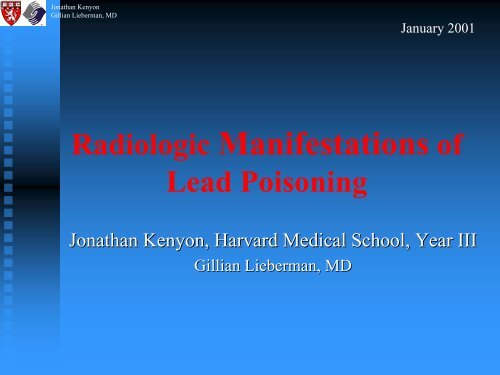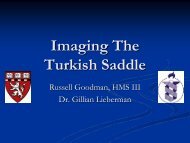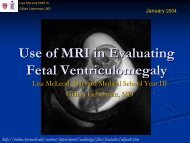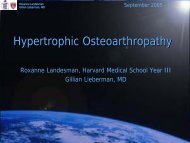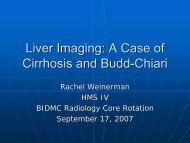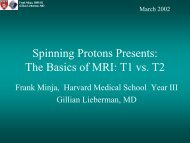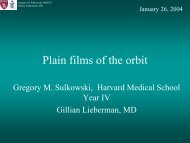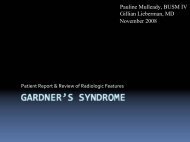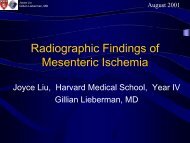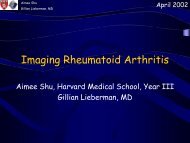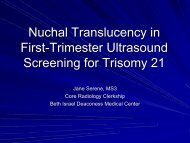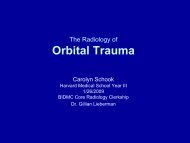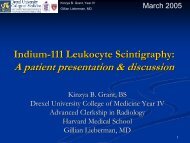Lead Poisoning or Plumbism
Lead Poisoning or Plumbism
Lead Poisoning or Plumbism
Create successful ePaper yourself
Turn your PDF publications into a flip-book with our unique Google optimized e-Paper software.
Jonathan Kenyon<br />
Gillian Lieberman, MD<br />
Radiologic Manifestations of<br />
<strong>Lead</strong> <strong>Poisoning</strong><br />
Jonathan Kenyon, Harvard Medical School, Year III<br />
Gillian Lieberman, MD<br />
January 2001
Jonathan Kenyon<br />
Gillian Lieberman, MD<br />
<strong>Lead</strong> <strong>Poisoning</strong> <strong>or</strong> <strong>Plumbism</strong><br />
Remains a significant problem in the United<br />
States, despite an eff<strong>or</strong>t to reduce lead<br />
contaminants.<br />
The department of health and human<br />
services called lead poisoning “the most<br />
imp<strong>or</strong>tant environmental problem f<strong>or</strong> young<br />
children.”<br />
2
Jonathan Kenyon<br />
Gillian Lieberman, MD<br />
Epidemiology<br />
Most common sources f<strong>or</strong> lead in a home<br />
are: lead-based lead based paint, drinking water, and<br />
pottery.<br />
<strong>Lead</strong> is either ingested <strong>or</strong> inhaled.<br />
98% of lead poisoning cases in children<br />
between 2-6 2 6 years old.<br />
3
Jonathan Kenyon<br />
Gillian Lieberman, MD<br />
Toxicity of <strong>Lead</strong> Exposure<br />
Mild Toxicity Moderate Toxicity Severe Toxicity<br />
Myalgias<br />
Paresthesias<br />
Fatigue<br />
Irritability<br />
Abdominal Pain<br />
Vomiting<br />
Arthralgias<br />
Headache<br />
Trem<strong>or</strong><br />
Paresis<br />
Encephalopathy<br />
Death<br />
4
Jonathan Kenyon<br />
Gillian Lieberman, MD<br />
Chronic <strong>Lead</strong> Exposure<br />
Shown to have neurological, behavi<strong>or</strong>al,<br />
and cognitive effects.<br />
Has been c<strong>or</strong>related with a direct decrease<br />
in exposed children’s IQ sc<strong>or</strong>es.<br />
5
Jonathan Kenyon<br />
Gillian Lieberman, MD<br />
Radiology and <strong>Lead</strong> <strong>Poisoning</strong><br />
Between 70%-95% 70% 95% of total body lead is<br />
found in osseous tissues.<br />
The half-life half life of lead in bone is up to 10 yrs.<br />
Nearly 70 years ago, Caffey and Park<br />
described radiologic manifestations of<br />
chronic exposure to lead in children.<br />
6
Jonathan Kenyon<br />
Gillian Lieberman, MD<br />
Patient A:<br />
2.5 Year Old Female<br />
Film findings:<br />
Dense Line at the metaphyses- a “lead line” <strong>or</strong><br />
“lead band.” This appears at a blood lead level<br />
of between 70-80 micrograms/dl.<br />
Image courtesy of Children’s Hospital, Boston, MA<br />
7
Jonathan Kenyon<br />
Gillian Lieberman, MD<br />
The <strong>Lead</strong> Line, A Disruption of<br />
Balance<br />
N<strong>or</strong>mal growth at the metaphysis is the result of a<br />
balance between osteoblastic bone deposition and<br />
osteoclastic bone res<strong>or</strong>ption at the Zone of<br />
Provisional Calcification.<br />
<strong>Lead</strong> ions are preferentially deposited at the ZPC,<br />
and disrupt this balance by inhibiting osteoclastic<br />
activity.<br />
Thus a “lead line” does NOT represent the<br />
radiopacity of the lead itself, but rather increased<br />
calcium deposition.<br />
8
Jonathan Kenyon<br />
Gillian Lieberman, MD<br />
Differential Diagnosis<br />
of Dense Metaphyseal Lines<br />
1) N<strong>or</strong>mal variant<br />
2) <strong>Lead</strong> <strong>Poisoning</strong><br />
3) Treated Leukemia<br />
4) Healing Rickets<br />
5) Other Heavy Metal <strong>Poisoning</strong><br />
6) Recovery from Scurvy<br />
7) Vitamin D hypervitamintosis<br />
Hypothyroidism<br />
Hypoparathyroidism<br />
Transplacental Infections<br />
8) Hypothyroidism<br />
9) Hypoparathyroidism<br />
10) Transplacental<br />
9
Jonathan Kenyon<br />
Gillian Lieberman, MD<br />
Patient B:<br />
20 Month Old Female<br />
Image courtesy of Children’s Hospital, Boston, MA<br />
Note Fibular<br />
Density<br />
10
Jonathan Kenyon<br />
Gillian Lieberman, MD<br />
<strong>Plumbism</strong> <strong>or</strong> N<strong>or</strong>mal Variant?<br />
Identification of a metaphyseal density in<br />
the proximal fibula is a strong indicat<strong>or</strong> of<br />
lead poisoning.<br />
This sign is the most reliable marker in<br />
differentiating between a n<strong>or</strong>mal and<br />
pathologic state.<br />
11
Jonathan Kenyon<br />
Gillian Lieberman, MD<br />
Diagnosis<br />
<strong>Lead</strong> bands are NOT an early manifestation of<br />
lead toxicity and thus should NOT be used to<br />
assess acute toxicity.<br />
A clinical hist<strong>or</strong>y of lead ingestion, symptoms,<br />
and blood lead levels are m<strong>or</strong>e reliable indicat<strong>or</strong>s.<br />
However, if blood lead levels are not readily<br />
available, radiography of knees should be<br />
considered in a symptomatic patient. Though not<br />
helpful in acute poisoning, they demonstrate<br />
findings with chronic exposure.<br />
12
Jonathan Kenyon<br />
Gillian Lieberman, MD<br />
Patient C;<br />
The evolution of a lead line<br />
4.5 year old female admitted with coma.<br />
Hist<strong>or</strong>y notable f<strong>or</strong> fever, vomiting, and<br />
progressive lethargy.<br />
Parents also noted that she had a “hist<strong>or</strong>y of<br />
eating paint from the veranda of her home.”<br />
13
Jonathan Kenyon<br />
Gillian Lieberman, MD<br />
Patient C<br />
8/20/66<br />
Image courtesy of Children’s Hospital, Boston, MA<br />
14
Jonathan Kenyon<br />
Gillian Lieberman, MD<br />
Patient C<br />
1/18/67<br />
Image courtesy of Children’s Hospital, Boston, MA<br />
15
Jonathan Kenyon<br />
Gillian Lieberman, MD<br />
Migration of <strong>Lead</strong> Lines<br />
<strong>Lead</strong> lines undergo a constant migration<br />
from the ZPC into the diaphysis. diaphysis.<br />
Different bones have different migration<br />
rates<br />
Distal femur - ~22mm/year<br />
Proximal tibia - ~15mm/year<br />
This growth related migration occurs f<strong>or</strong><br />
about 4 years, after which the lines<br />
disappear.<br />
16
Image courtesy of Children’s Hospital, Boston, MA<br />
Patient D;<br />
Unknown Hist<strong>or</strong>y,<br />
Evidence of Chronic<br />
<strong>Lead</strong> Exposure<br />
Note the alternating<br />
Narrow-Broad-Narrow pattern<br />
consistent among different<br />
bones<br />
Jonathan Kenyon<br />
Gillian Lieberman, MD<br />
17
Jonathan Kenyon<br />
Gillian Lieberman, MD<br />
Patient D - Chronic <strong>Lead</strong><br />
Exposure<br />
Image courtesy of Children’s Hospital, Boston, MA<br />
18
Jonathan Kenyon<br />
Gillian Lieberman, MD<br />
KUB as a means of Diagnosis<br />
Evidence of lead ingestion - Multiple<br />
radiopaque flakes representing paint chips<br />
may be seen on plain abdominal film.<br />
19
Jonathan Kenyon<br />
Gillian Lieberman, MD<br />
Patient E<br />
Film findings<br />
Radioopaque lead<br />
ingested in paint<br />
chips<br />
Image courtesy of Children’s Hospital, Boston, MA<br />
20
Jonathan Kenyon<br />
Gillian Lieberman, MD<br />
Another Radiographic<br />
Manifestation<br />
Widened cranial sutures may also be<br />
present in chronic lead poisoning,<br />
secondary to increased intracranial pressure<br />
21
Jonathan Kenyon<br />
Gillian Lieberman, MD<br />
Summary<br />
<strong>Lead</strong> poisoning is a serious and potentially<br />
life-threatening life threatening condition affecting<br />
primarily children.<br />
Chronically, lead poisoning results in the<br />
inhibition of osteoclastic activity. This is<br />
visualized on plain films as dense<br />
metaphyseal thickening in growing bones.<br />
Acutely lead toxicity should be diagnosed<br />
by H+P, and measurement of blood lead<br />
levels, though sometimes evidence of lead<br />
ingestion is visible on KUB.<br />
22
Jonathan Kenyon<br />
Gillian Lieberman, MD<br />
Sources<br />
Sachs HK. The evolution of the radiologic lead<br />
line. Radiology 1981; 139: 81-85. 81 85.<br />
Blickman JG, Wilkinson RH, Graef JW. The<br />
radiologic “lead band” revisited. American<br />
Journal of Roentgenology 1986; 146: 245-247. 245 247.<br />
Raber S. The dense metaphyseal band sign.<br />
Radiology 1999; 211: 773-774 773 774<br />
Caffey J. Pediatric X-ray X ray Diagnosis. 7th edition.<br />
1978<br />
Ellenh<strong>or</strong> M. Ellenh<strong>or</strong>n’s Medical Toxicology.<br />
1997<br />
Children’s Hospital Radiology teaching files.<br />
Boston, 23<br />
Boston, MA
Acknowlegements<br />
Beverlee Turner f<strong>or</strong> her supp<strong>or</strong>t and PowerPoint expertise<br />
Larry Barbaras and Ben Crandall our WebMasters<br />
24


